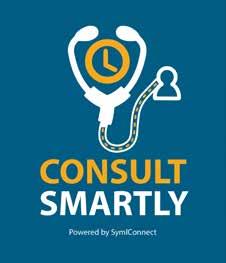
3 minute read
Consult Smartly: reducing the outpatient waiting list backlog
An innovative Welsh Health Hack 2020 winning project from Cwm Taf Morgannwg Health Board is addressing the severe outpatient waiting list backlog created by the impact of the COVID-19 pandemic. Consult Smartly is enabling secure patient-clinician remote communication and patient-clinician initiated flexible appointments.
The Need
As NHS staff continued their unyielding efforts in the fight to manage the Coronavirus pandemic, the national picture of the unforeseen crisis data emerged. Nationwide the NHS experienced significant backlogs in secondary care referrals review.
Welsh NHS figures revealed waiting times of over 36 weeks towards the end of 2020, an increase of 1,600% in some areas. The logistics involved in holding traditional face-to-face consultations were considerably more complicated due to the contagious nature of the virus. Existing manual procedures result in high percentage of non-attendance (DNA), consequently causing delays and valuable time and cost wastages.
A widely recognised positive change, ushered in by the pandemic, is the accelerated adoption of innovative digital technology, replacing manual processes to meet the demands required to protect, treat and monitor the population. Video consultation calls is one such technology that addressed the need of face-to-face consultations, virtually. Nevertheless, the waiting backlog is far from being addressed. Consult Smartly
Consult Smartly is a Welsh Health Hack 2020 winning project by Cwm Taf ENT Consultant Mr Mouli Doddi, partnering with SymlConnect, to design an automated seamless, digital virtual consultation platform for a more self-directed model of patient care, facilitating improved communication between patients and clinical teams.
Consult Smartly takes this video conferencing concept to an advanced level, allowing clinicians to create appointment time slots according to their availability, at the touch of a button. Patients experience enhanced flexibility, ‘choosing’ slots according to personal suitability. Thus, the appointment offering could be out of office hours as no clinic room preparation needs to be manned.
The advanced system incorporates patient consent, auto communication and auto reminders, consequently reducing the risks of non-attendance. The system integrates an online hearing test facility to assist effective clinical decision making during the video consultation.
Email or SMS messages would be used for ‘patient information giving’ communications, utilising questionnaire assignment to capture patient responses from the comfort of their own homes and triggering auto-reminders. Patient initiated follow-ups (PIFU) empower patients whilst encouraging self-management to develop a deeper understanding of their health conditions, which is a much-aspired feature portrayed in this system design. Specialist web design is being produced for the radical interactive communication element, for waiting patients once they click the secured video consultation link. A virtual waiting room with relevant and supportive information display is added to ensure patient support. The aspiration is to reduce the estimated cost and time of delivery for the current waiting list by one third, whilst delivering more than double the number of consultations than the existing appointment allocation manual process. The intention is to ease the process flow without demanding any extra resources or extended learning curves. SymlConnect proposes a modular system founded on their existing standards based multi-tiered modular software framework, for patient-clinician engagement permitting future interoperability with clinical/ administrative systems, enhancing clinical time usage whilst reducing administrative time requirements. Role-based user authentication, interactive reporting and respective clinical pathway logics are built in according to protocols. The flexible framework could be adapted to develop an asynchronous, seamless solution featuring user-friendly frontends and bespoke processes. Assistive communication technology opens up the visibility of patient flow and caregiving, based on informed decision making. Such use of technology aids in eliminating the possibility of human error whilst reducing financial detriment, delivering patient care in a prudent value-based way ensuring a sustainable health-care model for the future.








